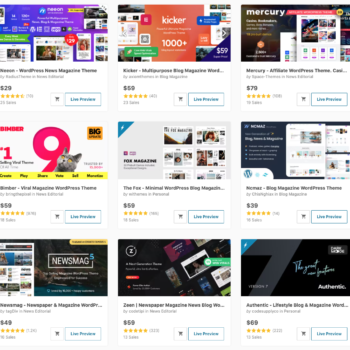If you’re a new blogger with lots of interests, the idea of choosing just ONE topic to focus on might feel overwhelming. Maybe you love crafting, cooking, and sharing DIY projects. It’s tempting to try and blog about it all!
But here’s the thing: trying to be everything to everyone often means your blog ends up feeling scattered and unfocused. Without a niche, it’s hard to attract your ideal readers, create content that really connects, and even make money from your passion.
The good news? Finding your perfect blogging niche is the key to building an engaged audience, creating content with ease, and opening the door to exciting monetization opportunities. Ready to get started?
Strategy 1: Passion Mapping
Let’s get those creative juices flowing! Passion mapping is like digging for treasure within your own interests. The goal is to uncover hidden connections and patterns that could lead you to your perfect blogging niche. Here’s how it works:
- The Brain Dump: Grab a notebook or open a new document. Start by listing absolutely EVERYTHING that sparks your interest. Don’t judge or overthink; just get it all out! This could include:
- Hobbies: Baking, photography, rock climbing
- Skills and Expertise: Web design, teaching, foreign languages
- Topics you love learning about: Psychology, personal finance, home decor
- Spot the Patterns: Now, step back and look at your list. Any themes emerge? For example, do you gravitate towards creative pursuits? Teaching and mentoring? Maybe your interests center around wellness or simplifying your life. Notice any surprising combinations?
- The “Aha!” Moment Sometimes, the perfect niche is hiding amidst seemingly unrelated passions. Let’s say you listed:
- Fitness
- Recipe Development
- Nutrition
These might feel separate at first. But what if you combined them into a blog focused on healthy, delicious recipes for athletes and fitness enthusiasts? That’s the power of passion mapping – it reveals possibilities you might not have considered otherwise.
Strategy 2: Transform Your Frustrations into Your Focus
Think back to when you first started exploring your interests. What obstacles did you hit? Maybe it was figuring out how to use a fancy new camera, finding the right ingredients for a tricky recipe, or carving out time for your hobbies while juggling work and other commitments.
Those frustrations are blogging gold! Here’s why:
- You Understand the Struggle: You’ve been there. That empathy makes your advice relatable and authentic, earning trust from readers.
- You (Likely) Found Solutions: To continue your own journey, you had to overcome those hurdles. This gives you valuable knowledge to share!
- Passion Born from Pain Points: Teaching others how to avoid the same pitfalls you faced can be incredibly fulfilling.
Turn Your Problems into a Profitable Niche
Ask yourself:
- What was the most frustrating part of starting out? Was it technical, mindset-based, lack of resources? Be specific!
- How did you overcome that challenge? Did you find an online course, a helpful book, or develop your own methods?
- Could you create a blog teaching those solutions? Imagine how satisfying it would be to help others avoid the struggle you went through.
Example: Struggling with time management + having a creative hobby = A blog teaching productivity for creatives.
This blogger clearly understands the pain points of trying to balance creative passions with “real-life” demands. Their solution-focused content would attract an audience eager for the specific help they offer.
Don’t Worry: You Don’t Need to Be a Guru
You don’t have to have solved every problem in your niche to start a blog. Simply being a few steps ahead of your ideal reader and sharing your journey honestly is incredibly valuable!
Strategy 3: Audience Analysis – Get Inside Your Ideal Reader’s Head
Think of your blog like you’re throwing a party. You wouldn’t just invite anyone and everyone, right? You want guests who will have a blast, enjoy the kind of food and music you offer, and make the party unforgettable. Your blog is the same way! Understanding your ideal reader is the secret to attracting people who will truly love and benefit from your content.
Who’s Your Ideal Reader? (Beyond Boring Demographics)
Forget just age and location for a minute. We want to dig deeper. Ask yourself:
- Desires: What do they dream of achieving or experiencing? (Example: If they’re interested in healthy cooking, maybe they want more energy or to shed a few pounds)
- Pain Points: What struggles and frustrations do they face? (Example: Maybe they feel overwhelmed by complicated recipes, or lack confidence in the kitchen)
- Online Habits: This is where to play detective! Do they love visual platforms like Pinterest? Hang out in niche Facebook groups? Get inspired by specific bloggers?
Where Do They Hang Out?
Knowing where your ideal readers spend their time online is like getting a treasure map to your audience! Here’s what to look for:
- Forums: Are there online communities dedicated to your niche where people discuss problems and seek advice?
- Social Media Groups: Search for Facebook, LinkedIn, or subreddit groups related to your topic.
- Blogs: What other bloggers are writing about similar topics? Check their comments sections!
What Questions Do They Ask?
This is your content goldmine! Pay attention to:
- Common questions asked in forums and groups: Note the specific wording people use – it’ll help you write blog titles that resonate!
- Blog comments: What kind of additional info are people seeking that the post didn’t fully answer?
- Quora & Answer Sites: Look for threads related to your niche and see what people are struggling with.
Let’s Get Practical: A Quick Exercise
Choose ONE potential niche you’re interested in. Spend 30 minutes sleuthing around online – forums, groups, etc. Make a list of:
- 3-5 common desires or pain points you notice
- 2-3 places your ideal reader likely hangs out online
- A few sample questions they’re asking
This gives you a blueprint for content that will hit the mark with your target reader!
Strategy 4: Profitability Check
Let’s be real, one of the reasons you’re starting a blog is the potential to earn some money from it, right? While your passions should guide your niche choice, it’s wise to check if your idea could realistically lead to a sustainable income stream. Here’s what to consider:
Can It Make Money?
- Products and Services: Do a bit of online sleuthing. Are there established products or services related to your niche? This indicates there’s an existing audience willing to spend money.
- Affiliate Marketing: Affiliate marketing means recommending products in exchange for a commission. Are there companies with affiliate programs in your niche?
- Your Own Products: Could you create digital products like eBooks, courses, or printables related to your niche? Brainstorm a few potential ideas!
Is the Market Saturated?
- A Little Competition is Healthy: Don’t be scared if other blogs in your niche exist. It shows there’s an audience! However, if it’s an oversaturated market filled with giant, established blogs, it’ll be tougher to stand out.
- Find Your Angle: How can you offer a unique perspective or cater to a smaller sub-niche within that broader topic? This is where blending your passions with audience needs really pays off.
Balance Passions with Potential
- Enthusiasm Fuels Success: Above all, you need to be excited about your niche! Blogging takes effort, and without genuine passion, it’s easy to burn out.
- Sustainability Matters: If there’s little to no monetization potential, can you sustain the blog purely as a hobby? If earning income is a goal, being realistic during this “profitability check” is crucial.
Remember, you don’t need a definitive answer to every question right now. The goal is to be aware of the earning potential (or lack thereof) as you consider your niche options.
Strategy 5: The Test Drive
Think of this step as taking a few potential niches out for a spin before deciding which one is the perfect fit for you. Here’s how:
- Pick 2-3 Contenders: Don’t feel pressured to decide right now. Choose 2-3 of the niches that seem most promising based on the earlier brainstorming strategies.
- Write a Few Sample Posts: For each niche, try writing 2-3 blog post outlines or even draft a short post. This isn’t about perfect content, it’s about getting a feel for the topic.
- The “Spark” Test: Pay attention as you write. Does one niche make you excited to keep writing? Do ideas flow easily? Can you picture the type of person who would eagerly read these posts? These are clues that you’re on the right track!
Permission to Pivot
Don’t panic if it takes a little experimentation to find your perfect blogging home. It’s absolutely normal (and even smart!) to tweak your niche as your blog grows and you learn more about yourself and your audience.
For example, you might start with a broad niche like “healthy living” and later narrow it to “plant-based recipes for busy families” as you discover your true passion and audience. Just remember, the most important thing is getting started with a focus, and giving yourself the flexibility to adjust course along the way.
Ready to Unlock the Power of Your Niche?
Remember, finding your perfect blogging niche is an amazing step towards success. A focused blog saves you tons of time, helps you connect with the right people, and positions you to make your content work for you – even financially! So, what are you waiting for? Grab your favorite notebook or fire up that laptop. Let’s get those ideas flowing!
Your Next Step: Choose one strategy from this post that sparks your curiosity and give it a try today. Need a little extra help? I’ve created a free brainstorming template to guide you through the process. [Include a link to download the template if you’ve made one!]
Let me know in the comments which strategy you’re going to try today! You’ve got this!









No Comments
Leave a comment Cancel